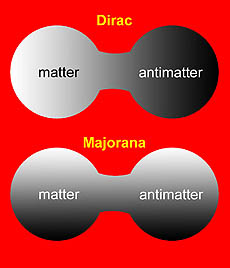 |
| If neutrinos are Dirac particles, their matter and antimatter versions are very different. If they are instead Majorana particles, the matter and antimatter components are the same thing. |
The neutrino is one of the most mysterious particles in the Standard Model. The original idea of neutrinos was formulated in response to a problem in beta decay, in which a neutron converts into an electron and a proton. (Historically, the electron in this kind of decay has been called a beta particle.) The problem was that energy seemed to disappear in the reaction. Either the principle of energy conservation had gone out the window or a non-interacting particle was emitted in the decay. Wolfgang Pauli proposed the second solution in 1930 in what he called a “desperate remedy.” His original name for this particle was the neutron, but this name was subsequently used to describe the familiar neutron in the nucleus, leading Enrico Fermi to propose neutrino (Italian for “little neutral one”).
Nearly massless, these subatomic ghosts can penetrate anything. Many trillions of neutrinos that originate in the thermonuclear furnace of the Sun pass through you every second of your life. If you filled space from here to the nearest star (about five light-years) with solid lead, you’d stop about half the Sun’s neutrinos. Neutrinos really don’t interact much.
Neutrinos have additional mysteries. For instance, they can morph into one another. Unlike their charged counterparts the electron, muon and tau, which appear to be distinct and immutable particles, the three types of neutrinos can convert back and forth as they travel. We call this behavior neutrino oscillation. Scientists first suspected this behavior based on studies of neutrinos from the Sun and also from cosmic rays. They subsequently confirmed their suspicions in 1998 at the Super Kamiokande experiment in Japan. Since then, active research programs at Fermilab, CERN and KEK, to name a few, have investigated the nature of these neutrino oscillations, and Fermilab is planning to structure a large fraction of its future scientific program around better understanding this phenomenon.
|



No comments:
Post a Comment